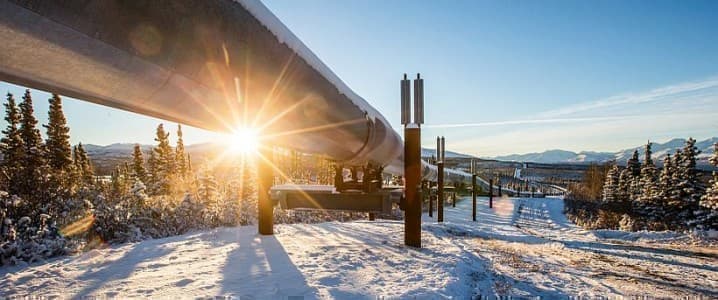An area of thawing permafrost is threatening a stretch of a major Alaskan pipeline as the structure experiences damages from the changing weather.
An 810-foot section of the Trans-Alaska Pipeline is under threat as the braces of the structure have begun to tilt and bend as the slope above it is slowly thawing. The Alaska Department of Natural Resources is responding to the hazard by installing 100 thermosyphon tubes over 120 days to pull heat out of permafrost and reenforce the slope to hopefully avoid major damage.
This is the first instance of ‘slope creep’ threatening the huge pipeline since its construction in 1977, according to local records.
The permafrost found beneath around 85 percent of Alaska has begun to melt in recent years because of rising temperatures in the region due to climate change. This will keep happening as temperatures are expected to continue to rise, meaning this will become a common threat to several different types of infrastructure in the state. Since the mid-20th Century Alaska has been warming twice as quickly as the global average, meaning energy and construction companies will have to take the threat seriously.
This is no new worry, as experts have been warning about building in permafrost prone areas for a long time. In China, we are seeing roads form large cracks as permafrost thaws. According to recent studies, steel, concrete and tarmac structures could be under significant threat over the next hundred years as temperatures rise and thawing permafrost becomes commonplace.
As well as roads and buildings affecting living conditions in these regions, pipelines in areas of permafrost pose a much larger threat due to the potential for oil spills. Thawing frozen ground under Russia, Canada, China and the United States has been highlighted as a likely challenge to oil and gas infrastructure for around the last decade.
In 2012, the UNEP released a report on the threat, highlighting the 1994 Vozei pipeline failure in Northern Russia, which resulted in the spilling of 160,000 tonnes of oil. In addition, the thawing of large areas of permafrost could mean the release of substantial amount of carbon dioxide into the atmosphere, further adding to the threat of climate change.
Related: Huge Dividend Cripples World’s Largest Oil Company
Heading forward, oil and gas companies planning to construct or continue operations in permafrost regions must plan for the thawing upon construction, putting safeguards in place to ensure the structure remains stable.
However, when it comes to the Trans-Alaska Pipeline, the companies involved are adamant that the giant tube was well-prepared for permafrost upon its construction. Michelle Egan, a spokeswoman for Alyeska, an association of oil companies stated, “permafrost changes were anticipated during the original design”. “The construction mode and method of pipe support are designed to maintain the integrity of the pipeline and minimize impacts to the environment.”
There are currently 124,000 thermosyphons dispersed along the pipeline, as a precaution, aimed at keeping the ground frozen and the structure’s supports safe. However, the new thermosyphons installation will be the first against a looming threat rather than a safeguard, demonstrating to firms whether this is a reliable response method or not over the coming months and years.
So as Alaska battles with its permafrost, acting quickly to avoid disaster, firms across these regions must consider how to act in advance of climate change to protect major infrastructure from changes in the environment.
ADVERTISEMENT
By Felicity Bradstock for Oilprice.com
More Top Reads From Oilprice.com:
- Natural Gas Prices Still Have Room To Run
- A Contrarian Investor’s Approach To OPEC’s Oil Spat
- U.S. Shale Can’t Afford To Gamble On The OPEC+ Outcome


















